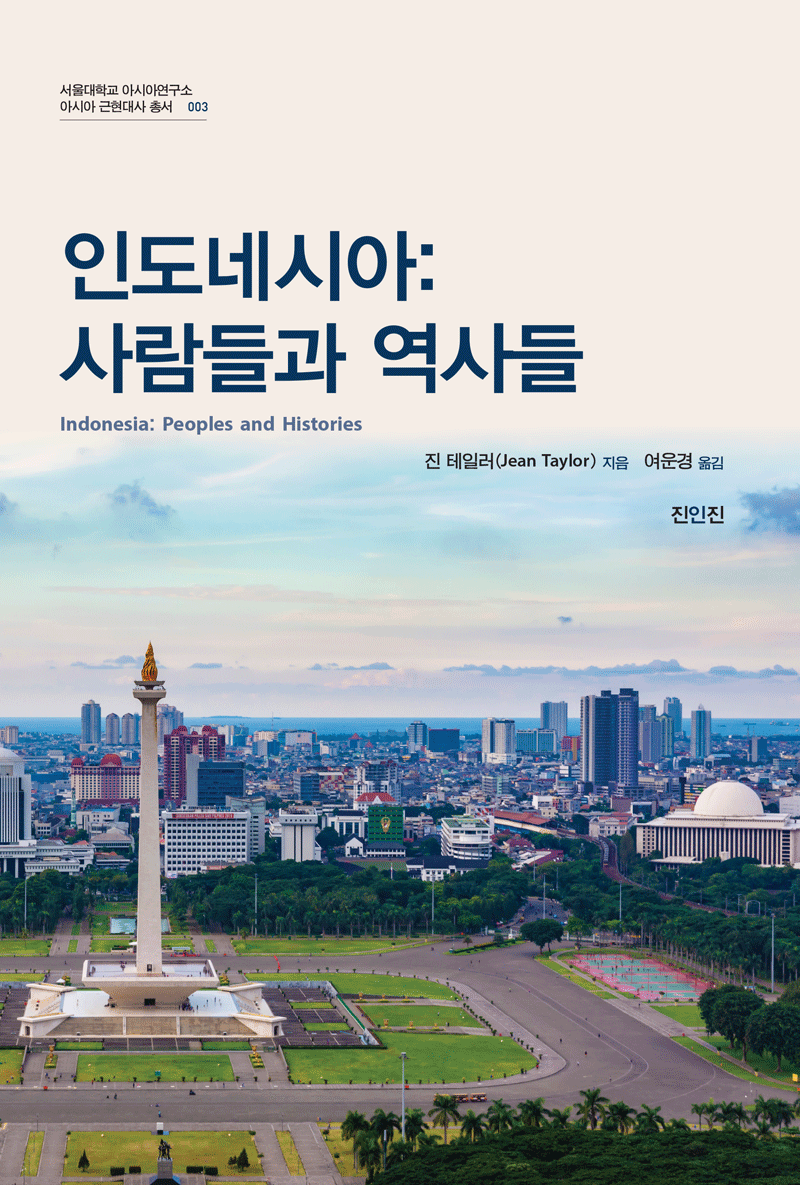Indonesia: Peoples and Histories

- Author: Jean Taylor
- Translators: Woonkyung Yeo
- Publication Date: August/ 2023
- Publisher: Zininzin
Preface 11
Introduction 19
Early Beginnings: Histories Through Material Culture 25
Communities and Kingdoms: Histories Through Writing and Temples 51
Sultans and States: Histories Through Islam 87
Monarchs, Mentors, and Mobile Men: Embedding Islam in Indonesian Histories 119
Newcomers in the Muslim Circle: Europeans Enter Indonesian Histories 149
Inside Indonesian Sultanates: Dutch Vassals, Allies, Recorders, Foes, and Kafirs 181
New and Old States: Freelancers, Prophets, and Militias at Large 217
Maps and Mentality: European Borders Within Indonesian Worlds 259
Many Kingdoms, One Colony: Bringing Indonesian Histories Together 295
Breaking Dependence on Foreign Powers 343
Rearranging Map and Mind: Japan and the Republic in Indonesian Histories 379
Majapahit Visions: Sukarno and Suharto in Indonesian Histories 413
Glossary 467
Bibliography 473
Translator’s Note 515
Index 527
Author
Jean Taylor
Associate Professor Emeritus at New South Wales University, Australia. She received her bachelor’s and master’s degrees from Melbourne University, and her Ph.D. in history from the University of Wisconsin. Major research areas are Indonesian history, especially Indonesian socio-cultural history, Islam, gender, modernity, and identity. She has taught Southeast Asian history and Islamic civilization at New South Wales University. Her books include Global Indonesia (2013), Cleanliness and Culture: Indonesian Histories (2011, co-authored), The Emergence of Modern Southeast Asia (2005, co-authored), The Social World of Batavia (1983), with major articles including “The Sewing-Machine in Colonial-Era Photographs: A Record from Dutch Indonesia” (2012), “Painted Ladies of the VOC” (2007), “Meditations on a Portrait from Seventeenth-Century Batavia” (2006), and “Kartini in her Historical Context”(1989).
Translator
Associate Professor, Dept. of Asian Languages and Civilizations at Seoul National University. He graduated from the Department of Asian History at SNU and received his master’s degree in Southeast Asian Regional Studies from GSIS, SNU, and his Ph.D. in history from the University of Washington. Major research areas include Indonesian history, especially the sociocultural change and transnational mobility of 20th-century Indonesia. Translated publications include Exile: Conversations with Pramoedya Ananta Toer (2012), and major articles include “Illegalising Licitness? Bartering along the Indonesian Borders in the Mid-Twentieth Century” (2016), “Piracy and Smuggling in Postcolonial Southeast Asia: A Case Study of Sulu Sea” (2022), and “In Search of Westerling: The Decolonization of Indonesia and the Dutch Question in the 1950s” (2018).
Inside the Book
A major introductory book by Jean Gelman Taylor, the Australian expert on Indonesian history, Indonesia: Peoples and Histories, has been translated into Korean.
Jean Taylor is an Associate Professor Emeritus at New South Wales University, who rose as an expert in modern Indonesian history with her 1983 book The Social World of Batavia, which illustrated the various aspects of Batavia (current day Jakarta) in the 17th and 18th centuries. In this book, she mostly dealt with the lives of people of various races and cultures in Batavia, a city created by the Dutch in the early 17th century. She especially explored the Europeans, the mixed-blood population, and the lives of women, newly casting a light on the lives of Batavia from a perspective of daily life.
Indonesia: Peoples and Histories, which was first published in 2003 and translated into Korean this year, focuses on the various contexts that influenced the formation of the modern state and reconstructs Indonesian history through a multifaceted perspective that departs from the existing political or economic perspective on history. Starting from the perspective on affairs of the state that focuses on the change of regimes, colonial rule, and the formation of the nation-state, the book goes beyond the narrative that concentrates on the central area (Java, Jakarta) and the political elites and expands into the socio-cultural aspects such as the people, material culture, and daily life.
The author’s new perspective suggests various views with a focus on socio-cultural trends that differ from the existing time-based narrative and has created a great sensation in the field of Indonesian and Southeast Asian history. The book is still being evaluated as a major introduction to Indonesian history.
The book offers a new light on the past and present of Indonesia through a viewpoint that embraces diversity and reality based on a comprehensive understanding of Indonesian history. It is a book that will help an in-depth understanding of the cases of the southern hemisphere, which is required for Koreans as a new world order is being established.
